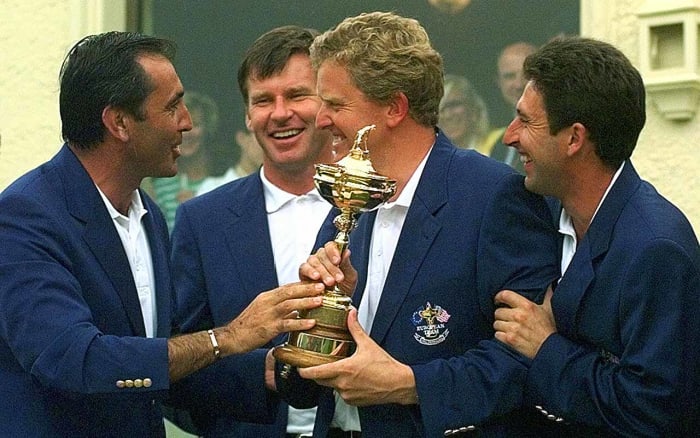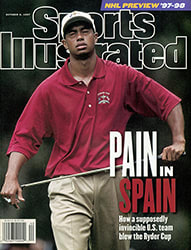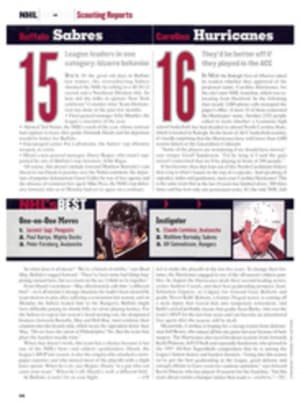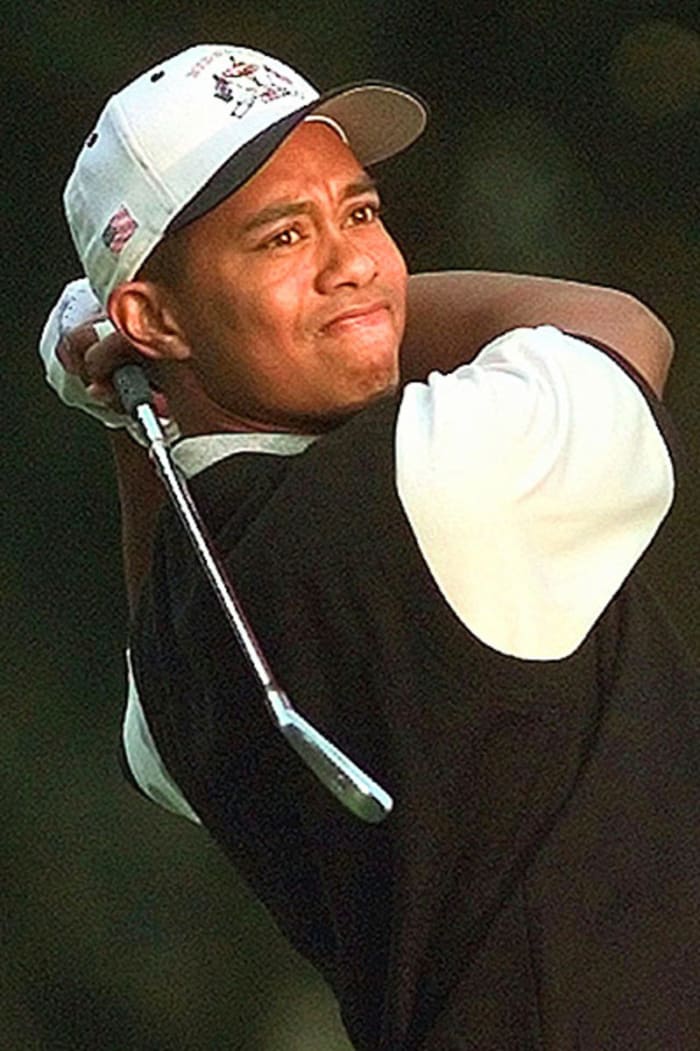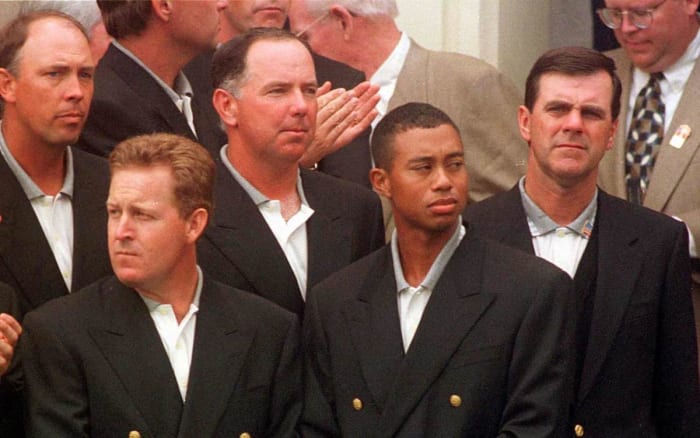Ole! Ole!
It was Seve all the way. It was Seve's Ryder Cup, in Seve's Spain, on Seve's trap-sprung course, won by Seve's hand-wrangled team, played under Seve's terms, for Seve's honor. It was Seve everywhere you looked, Seve in the world's only Formula One golf cart, driving rings around U.S. captain Tom Kite, cutting through bunkers, sending fans flying and separating them from their disposable cameras, showing up wherever Seve was needed and showing up wherever he wasn't, lining up putts, arguing over club selection, handing out advice and inspiration and, quite often, a sandwich. It was Seve driving his players out of their minds and straight into the most flawless golf some of them had ever played. It was Seve and the only result he could have lived with, a win by Europe over the U.S. last week at the soggy Valderrama Golf Club in Sotogrande, Spain. Yeah, Seve won the Ryder Cup and never fired a shot.
True, it was also Scotland's Colin Montgomerie and his big mouth and even bigger game. And it was England's Nick Faldo becoming the alltime Ryder Cup gorilla. And it was Tiger Woods becoming the first cat ever to lay an egg, and it was Davis Love III going 0-fer-Spain. But above all, this Ryder Cup was about Severiano Ballesteros, Europe's first-time captain, soul and tyrant. "Whenever we were unsure of a shot, Seve would appear, out of the blue," said Spain's Ignacio Garrido. "He was our father. We may have held the clubs, but Seve hit the shots."
Kite did a wonderful job, too, except that he departed Spain looking like a hoodwinked tourist, with an empty wallet, an upset stomach and a Spanish doubloon that will turn green on his nightstand. Everything Seve wanted, Seve got—and a lot of it Kite let him have.
Seve wanted the Cup held in Spain. He got it. Seve wanted the unheard-of Miguel Angel Martin, who had made his team, to get the bum's rush in favor of Seve's soulmate, Jose Maria Olazabal, who hadn't. He got it. Seve wanted the format flipped so that the better-ball matches came before the alternate-shot matches. He got it. Seve wanted the course tweaked to disarm U.S. bombers such as Woods (1-3-1 on the weekend), Love (0-4) and Phil Mickelson (1-1-2). He got it, pinching many of the fairways at 270 or 280 yards and putting ugly new swaths of rough across the middle of others so that half the time the Americans seemed to be punching out of paella.
"Seve took the drivers out of their hands," said Faldo, a short knocker and happy for it. "I played with Tiger, and he only hit a driver once."
Seve and his team were so far ahead of the Americans that this became history's only two-day Ryder Cup. The last day saw a mad U.S. rush to make the score look respectable, with victories in seven singles matches out of 12, but it was all just polishing the brass on the Titanic. Hell, you had the feeling the Yanks were doomed the minute they got on the Concorde. Somewhere over the Azores, Brad Faxon hit a ball from the cockpit to the back galley, and it didn't stop until 23 seconds and 8.7 miles later, a world record for time and distance traveled by a golf shot. That was the last putt of any significance that an American made. The Europeans got their 8.7 miles' worth, only in smaller chunks. "They just made tons of putts," an exhausted Tom Lehman (1-1-2) said on Saturday. "And we didn't make squat."
When the Yanks landed, Seve was in their faces. "I have 12 guys who can beat Tiger Woods," he said, setting the tone. Montgomerie picked it up from there, taking a slap at Woods by telling the Glasgow Herald, "With all due respect to Lehman, [Justin] Leonard and Love, who are their next three top guys? Beating them doesn't mean as much." Even the fans got into it, parading around the cork trees of Valderrama wearing TIGER: NOT THE FULL MONTY T-shirts. They were right. Montgomerie earned 3 1/2 points, Woods just 1 1/2.
Seve ran his team the way an absolute monarch would have. When he announced his morning pairings for the first day, he hadn't even warned the players he was benching. "I suppose they will see it on TV right now," he said. Kite told his benched players personally, presumably with a comforting hug.
Kite promised all his players they would play each day of the team matches, and they did, and everybody felt very included and the Americans got very creamed. Seve sat three players the first day: Wales's Ian Woosnam, Northern Ireland's Darren Clarke and Denmark's Thomas Bjorn. "Do you believe that?" a U.S. player said. "Woosie's a what, seven-time Ryder Cupper? That's bull."
All three of the benched Europeans went out on Saturday and won. "Maybe that's what I needed," said Woosie. "Something to get me mad."
Seve was manic, but the players understood. Making him surrender the Cup in his own country was more than they could bear. "We can't let that happen," said Monty. "He'd be a blubbering mess."
Seve was a mess as it was. On Thursday, the day before the matches began, the phone rang at 5:15 a.m. in the room of Seve's Sancho Panza, assistant coach Miguel Angel Jimenez. "Come to my room," Seve said. "We need to discuss the pairings." The pairings weren't due until 2 p.m.
"Are you crazy?" Jimenez said groggily.
"Well, this is very important."
Jimenez went.
The Daily Mail of London reported that during practice on Thursday Seve made Faldo, Montgomerie and Germany's Bernhard Langer play the 17th over again. They hadn't done it right, he said.
Kite, meanwhile, was into undermeddling. He said his main goal was to make sure his team "had one heckuva time, no matter what the outcome." Camp Kite was a very happy place until widespread sucking set in. The captain attributed America's loss to a lack of course knowledge, but he had invited the top 25 U.S. golfers to go to Valderrama with him in July, before the British Open, to get a feel for it. Only three players who ended up on Kite's Ryder Cup team went. "I wasn't forceful enough," Kite said.
He was not a force during the week, either, showing up mostly for moral support, with his wife and kids—and, on Saturday, Michael Jordan—in his cart. Seve didn't cart around his kids, and he made his wife walk with the other wives. Wife and kids on the Seve Chevy? Are you mad? Clarke and Woosnam rode with him one day as he screeched around the course, and they lived to regret it. Barely. "They were a little scared," Seve admitted. You talk about a Rider Cup.
Exhibit A of how Kite got outcaptained: As the Americans' world fell in on Saturday—they wouldn't win a single point the entire day, the first time this had happened to any team since 1967—Lee Janzen and Jim Furyk had a 35-foot putt in the near darkness on number 18 in their alternate-shot match against Montgomerie and Langer. If the U.S. could just two-putt, it would likely win the hole and save half a point. Anybody would have said, "Let's just call it an evening and come back tomorrow, when we don't have to read bentgrass in the dark." Plus, Monty hadn't sat out a match the first two days. To make him get up early the next day, finish the alternate-shot match and then play a singles match hours later might just have killed him. But Kite was nowhere around to offer that kind of advice. He didn't arrive until after Janzen had bombed his putt 10 feet by and two seconds before Furyk slapped the comebacker badly past the cup. U.S. concedes hole. U.S. loses match. Monty sleeps in. Monty ties a battling Scott Hoch the next day for the half point that gives Europe the win, 14 1/2 to 13 1/2.
It was never that close. In fact, the Europeans never trailed in these matches. They scored the first point of the first day when Mickelson clanked a huge six-foot putt to lose to Italian Ice (Costantino Rocca) and Olazabal. Europe led 4 1/2 to 3 1/2 at the end of the first round. Then, on Saturday, Seve and his toreros turned the fairways red with American blood.
In the morning better-ball matches the U.S. lost three outright and tied a fourth. The most amazing half point of the week was that of Spain's own, Olazabal and Garrido, against Lehman and Mickelson. Mickelson hit "the single greatest shot I've ever seen," in Lehman's words, on the 17th, the trick hole Seve had redesigned. (The Americans would go 1-2 there during the doubles matches. Woods never seemed to figure the hole out and even putted into the lake once.) Under serious Gs of pressure, Mickelson hit a two-iron out of the rough from 239 yards to within six feet of the jar. An eagle here would put the U.S. one up with one to play. Then Mickelson blew the putt, his second spirit breaker in two days. "Pienso que mas a la derecha, pero no," Mickelson said, to the delight of the Spanish interpreter. (He meant, "I thought it would break more to the right, but no.")
Garrido, meanwhile, hit his second shot into the steep, fake-Augusta 13th back bunker, which nobody had gotten up and down from all week. Garrido got up and down. "Maybe the second-greatest shot I've ever seen," said Lehman.
On to 18, all tied. Olazabal hit his drive into the trees and onto a bed of bark chips. He dropped from the chips. Seve was there, of course, wondering what club he was going to hit. "Seis," said Olazabal.
"Siete," said Seve.
"Seis."
"Siete."
Ollie hit siete into the front-right bunker. Then he knocked the ball out of the bunker to 18 feet and drained it for a half point, followed by one of the loudest and most hair-straightening roars that have been heard in the Andalusian hills. Ollie not only made a barkie, a chippie, a droppie and a sandie, but he also survived a Seve, which ought to be worth an Emmy.
The point is, that's the way the whole day went. The Europeans played as if their houses were in the pot. By nightfall Europe led 9-4, which in a Ryder Cup is like saying Dallas 52, Buffalo 7 halfway through the third quarter. There were 15 matches left, in which the Americans would need to score 10 1/2 points. In other words, they were slightly more dead than Franco.
Still the U.S. came out on Sunday and promptly started fighting some serious windmills. Lehman, Mickelson, Fred Couples, Jeff Maggert and Mark O'Meara all won going away, in some of the most sensational singles performances in recent Ryder Cup history. But Love lost to Sweden's Per-Ulrik Johansson in a shocker, and Tiger lost to Italian Ice, and then Faxon missed a 10-footer to stay alive against Langer, and it all ended right there at 17—where else?—as the Europeans clinched at least a tie to retain the Cup.
Your MVG (Most Visible Goat) was Love, in a landslide. "Look at the board," he said. "If Tiger and I win our matches, the Cup's ours." In fact, the three Americans who won majors this year—Leonard, Love and Woods—went a combined 1-9-3 in Spain.
Ah, well, there's still a few Yank consolations: We can probably whip the Europeans country against country. And Tiger could draw cards for any three Euros' combined net worth. But we will never have a Seve. To the end Seve was the King of Spain. He called this win his "greatest achievement," then resigned from the job, saying he would like to return as a player for the '99 Ryder Cup and then captain again in "maybe 2005." Any questions?
If the U.S. ever wants to beat him, it must do the following, as soon as possible:
1) Move the Ryder Cups held in the U.S. to courses the American players know. Forget The Country Club in Brookline, Mass., site of the '99 Cup. American Tour players don't go there. How about the TPC at Sawgrass? Or Augusta National? Think Tiger might get more than a point and a half there?
2) Dump this happy-family stuff. Get an s.o.b. in there—Hale Irwin, maybe?—who won't care if he spikes some toes. I don't care how late it is, I said we're going out to hit two-irons! Let's move! And....
3) Call the Penske people. We gotta get working on a better golf cart.
